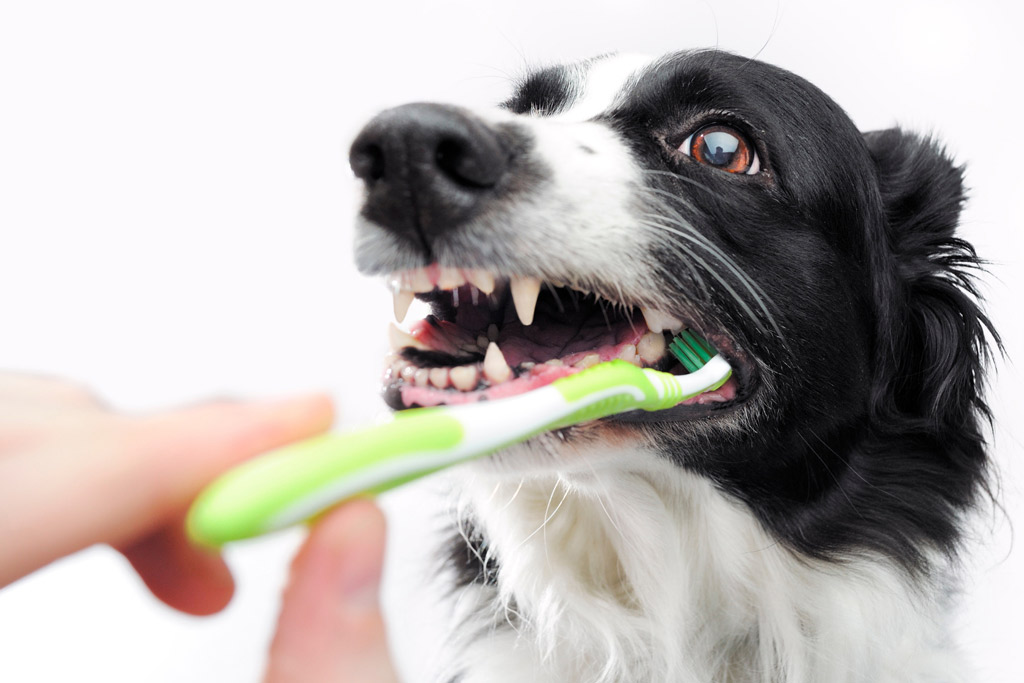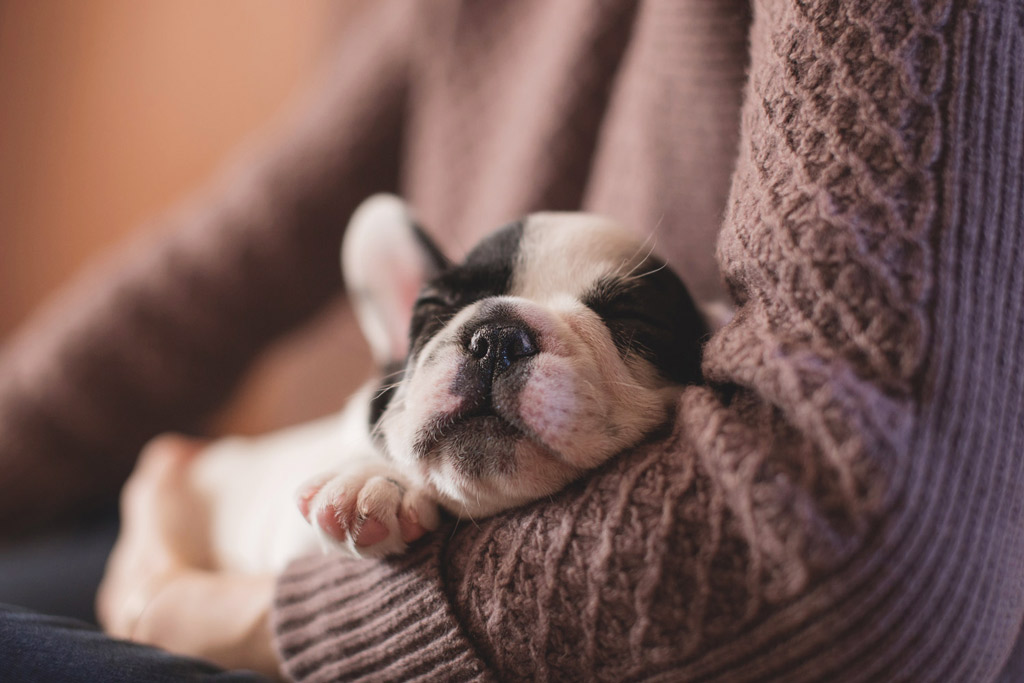
A healthy dog lives longer and happier! And as dog parents, that’s all we want.
In today’s fast-paced world and busy lifestyle, it’s easy to get lost with so much advice or fall behind on the responsibilities you committed to as a dog parent, because you lack time.
This happens more often than you or I would like to admit; no one is perfect.
That’s why I sort out to approach dog care and it’s pillars from a regular dog parent and dog fosterer’s point of view. I personally found certain advice ideal but unrealistic to apply to my lifestyle.
My experience and research have taught me that it’s very important to know and cater to a dog’s need.
So, when caring for a puppy or dog, I will be addressing their 5 basic needs:
- Environment.
- Nutrition.
- Activities.
- Health.
- Grooming.
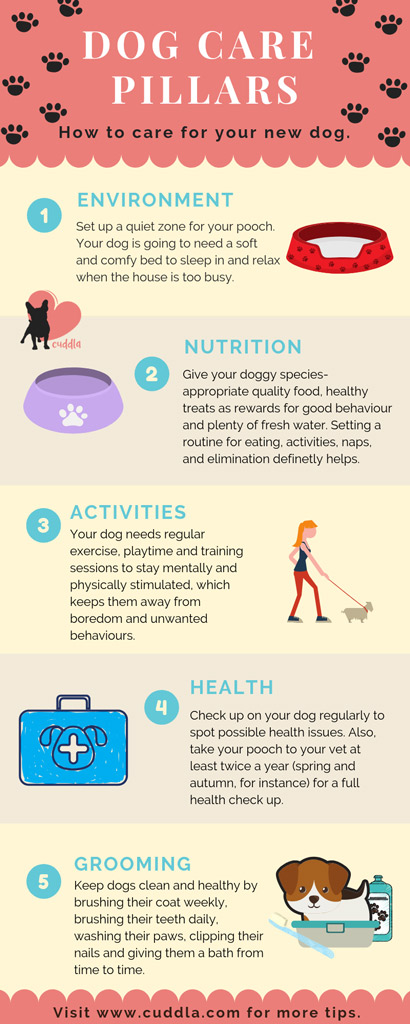
These 5 points meet the dog’s welfare needs, which are included in The Animal Welfare Act.
This is a holistic approach to dog care, looking at things from an overall perspective and addressing the reasons (causes) makes more sense to me than going for a solution that mitigates the problem but doesn’t solve it i.e. a temporary solution.
#1 – Environment
Believe it or not, your dog’s environment plays an important role in dog care. But, what does it mean?
- A dog-friendly home (for your dog’s safety and comfort).
- A dog safe zone (your dog’s own space, a dog room).
- Companionship (spending time with your dog and petting him or her).
Craft a Dog-Friendly Home Environment
Do you know what works best in your house when you have pets at home? Or are you planning on making some changes to your house interior to accommodate your furry friend?
A dog-friendly home is essential for your pup’s safety, comfort and health. Here are some things to consider and check off your list:
Pick Durable Materials
Pick up durable materials for:
- Flooring, such as tile, vinyl, or stone, that is easy to clean, stain-resistant, and toenail proof.
- Wall colours and treatments; light colours will be more likely to show dirt. It also is easier to wipe smudges off of a satin paint finish.
- When getting furniture, wood might not be a good idea if you have a “scratcher” putting his paws where he shouldn’t or a frequently drooling dog.
Minimize Dirt as Much as Possible
It goes without saying that you should clean litter boxes regularly.
Brushing and washing your dog when necessary can help hold off hairballs, dirt from paws, and dog odours.
Additionally, establishing a dog-friendly area at a hall entry or in a mudroom can prevent dirt from being tracked throughout your home.
If you’re planning to install a dog door, the hall entry is a great place to put it to restrict your dog from the rest of the house, while still providing free access to the outdoors.
Keep Safety in Mind
Safety is paramount in a dog-friendly home.
- Hide all the cables.
- Childproof your home with cabinet locks, as well as trash-can and toilet-bowl lid latches, so your curious pet stays away from harm and potential hazards.
- Be careful with your curtains, as they attract pet hair, dander, and odours. Wood blinds or vertical blinds are a great alternative.
Create a Toxin-Free Environment
Common household items can be hazardous to dogs, so it’s good to familiarize yourself with the top pet toxins — a list that includes medication, plants, people food, cleaning products, pesticides, and fertilizers.
It can be a challenge to combine a desire for a ‘green’ environment with the need for household furnishings that are pet-proof and easy to keep clean.
However, bear in mind that your pets live at ground level and are also likely to spend many more hours lying on furniture than the human members of the household.
You can further reduce the environmental pollutants in your home by using non-toxic cleaning solutions.
Some house plants including poinsettias, holly, ivy, mistletoe, and lilies can be toxic, so avoid these or keep them out of reach. You can still add household plants that improve the air like a spider plant, peace lily, and chrysanthemum.
P.S. I cover some handy, practical tips for a dog-friendly home in our How to Make Your Home Dog-Friendly and Safe blog post, where you will also find a room-by-room checklist to dog-proof your home!

Craft the Ultimate Dog Safe Zone
Providing your pooch with a cosy and quiet place where she can retreat to (at all times) is very important.
This is an area where your pooch can retreat to rest or have a nap, or not get disturbed when the household gets busy. Plus, you can also place some toys and familiar items in this area.
A dog safe zone isn’t hard to create, but it does require some thought. You want to make sure that your dog’s spot is safe and comfortable for her inquisitive nose and playful manners.
Also, establish a feeding area where you are going to be placing your dog’s bowls for food and water. You probably want to remove the food bowl after your doggy finishes eating, so you have some control over the feeding schedule. But, always keep a water bowl around a corner so your furry friend always has fresh water available.
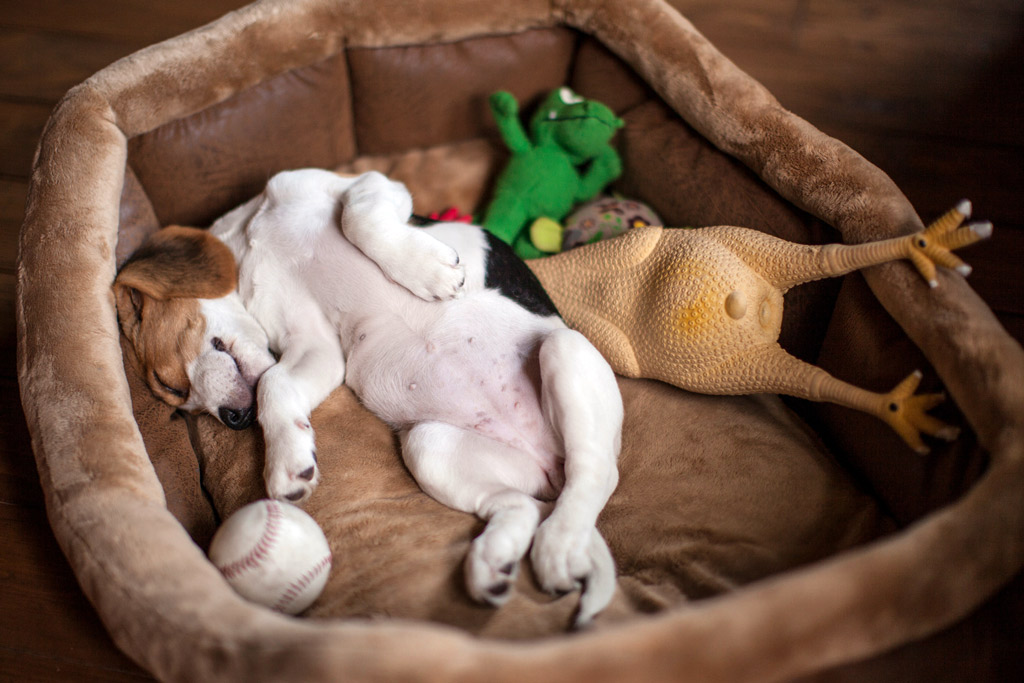
Companionship
Although cuddle time might come naturally to some people, dogs need us to spend quality time with them exercising, playing, training and, of course, petting them!
Spending time with your pooch is another responsibility for dog owners and this opens up the question of how leaving your pooch alone at home for too long affects them.
According to PSDA, the maximum amount that you should leave your dog alone is 4 hours.
However, reality looks different. So, if you find yourself having to leave your pooch for a while, read on…
Considering Leaving Your Dog Alone at Home?
You can either limit the space where he’s allowed or pick a small space and put all his toys around. Either way, he will be restricted from wandering around the rest of the house. Plus, he will be distracted for a while from destroying anything valuable.
However, you should test it a few times before leaving him for a long time. Try 15 minutes at first, then 40 minutes, and advance to an hour, etc.
Also, consider crate training as part of house-training your pup. Your dog should sleep in his crate or playpen at night and take naps in it throughout the day. This will help your puppy learn to stay in a restricted area by himself and feeling good about it.
To train him to love his playing and resting area, you can make it cosy:
- Add a bed.
- A blanket.
- And some toys.
The supreme goal of crate training is that he goes into this area on his own, and also when you give him a verbal cue, as opposed to needing to be shoved or coaxed in. And once he’s in, he remains relaxed, comfortable and quiet.
Finally, you should expect your puppy demanding some quality time with you after expending some time by himself 🙂
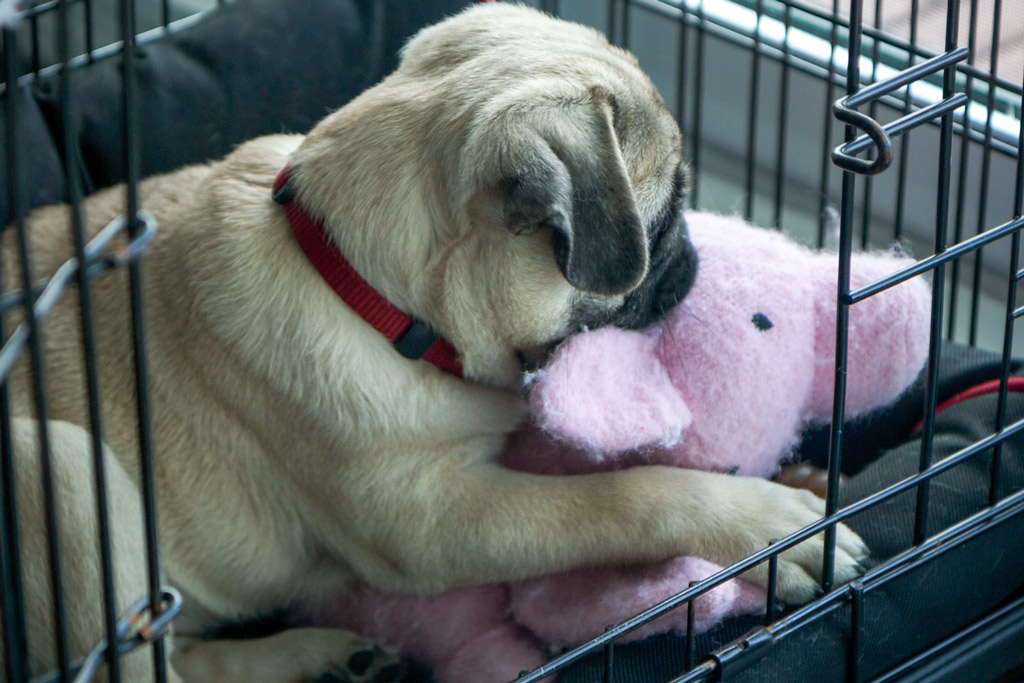
#2 – Nutrition
It is important to follow a species-appropriate diet. This is true for humans as well as for dogs, especially since the appearance of processed food.
From a genetic standpoint, domesticated canines and felines are essentially the same as their wild counterparts, who are carnivores. This means that dogs evolved to consume a low-carbohydrate diet. Since they are carnivorous animals, they must eat fresh whole prey for optimal health.
But for the last century, the majority of dog owners have fed their dogs a high-carbohydrate, low-moisture diet, i.e. commercial pet food. This new diet has created significant metabolic and physiologic stress in our dogs. It has even become the root cause of most of the inflammatory processes and degenerative disease we see in veterinary medicine today.
Essential Nutrients for Your Dog
Before thinking of what to give your dog to eat, let’s look at what nutrients dogs need in their diet to be healthy.
Whether you buy your dog food or make it yourself, your dog needs a balanced diet which is species-appropriate to stay healthy. That kind of diet includes a mix of:
- Proteins.
- Fats.
- Vitamins.
- Minerals.
- Water.
Balanced Dog Meals
So how can you make sure that your dog gets all the nutrients needed for a healthy and long life?
A Balanced and Species-Appropriate Diet
A healthy, species-appropriate dog diet should include:
- High-quality protein – muscle meat, not pieces or parts.
- Moderate level of animal fat.
- High levels of EPA and DHA.
- High moisture content.
- A few fresh cut veggies (mimics prey’s stomach contents).
- No grains.
- No potatoes or other starches.
Plus, your furry friend should be well hydrated.
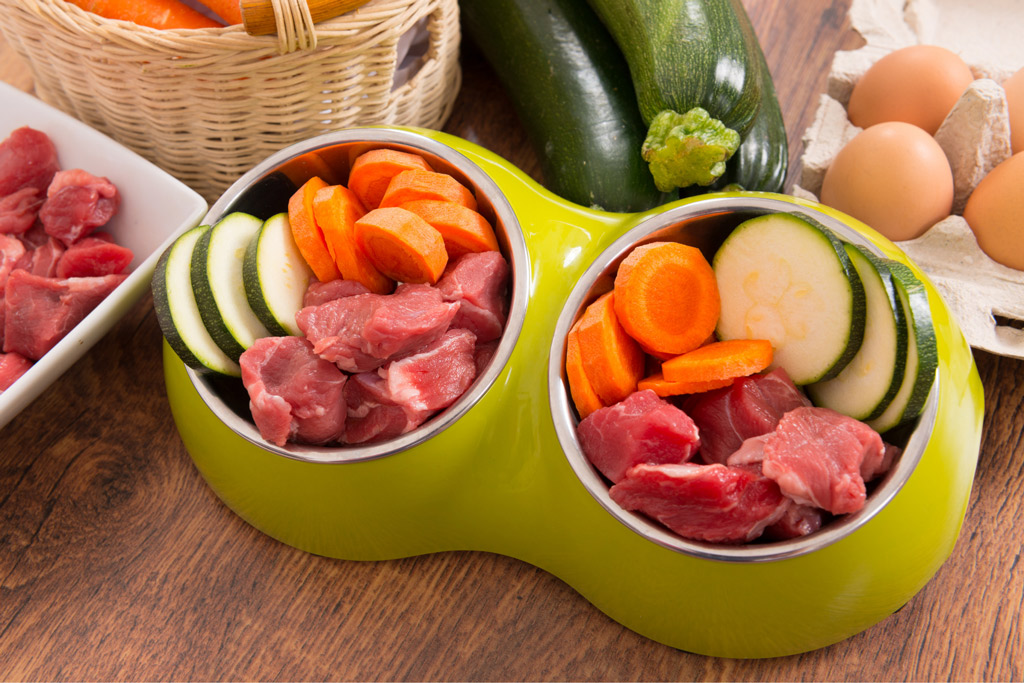
Supplementing a Dog’s Diet
Food doesn’t always contain all the nutrients your dog needs, no matter if it’s commercial or homemade.
High-quality and natural dietary supplements can be extremely beneficial to your dog’s health and longevity. Plus, they guarantee that your dog is getting the right nutrients.
Here are some natural supplements that can help your dog:
- Probiotics and Digestive Enzymes: For the gastro-intestinal (GI) tract health.
- Curcumin and Chlorella: For liver and kidney health.
- CoQ10: For the heart.
- Collagen: For joint health.
- MCT Oil: For cognitive health.
- Krill Oil: For skin and coat health.
To know more about natural dog supplements, head over to our Natural Dog Supplements with Health Benefits You Must Know About blog post for a deep-dive.
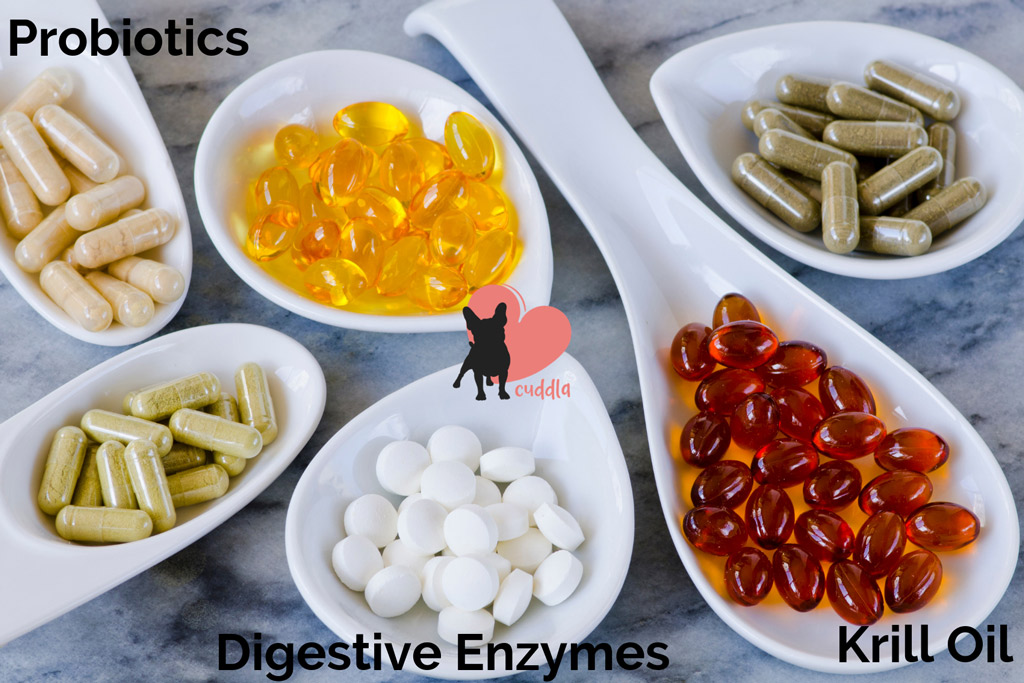
Types of Dog Food
Once knowing what nutrients your dog needs to stay healthy, the next step is to understand what dog food contains, so you can choose what’s best.
Dog food can be dry or fresh. Also, it is important to understand the moisture status. Your dog might prefer more moist food, so you can pay attention to your friend’s preferences.
There are five types of food that you can give your pooch:
Commercial or processed dog food:
- Kibble.
- Canned.
- Semi-moist.
Homemade dog food:
- Home-cooked.
- Raw.
For a more thorough look at dog foods, essential nutrients and meal schedules, our Dog Nutrition blog post will give you the general knowledge you need and addresses these points in further detail.
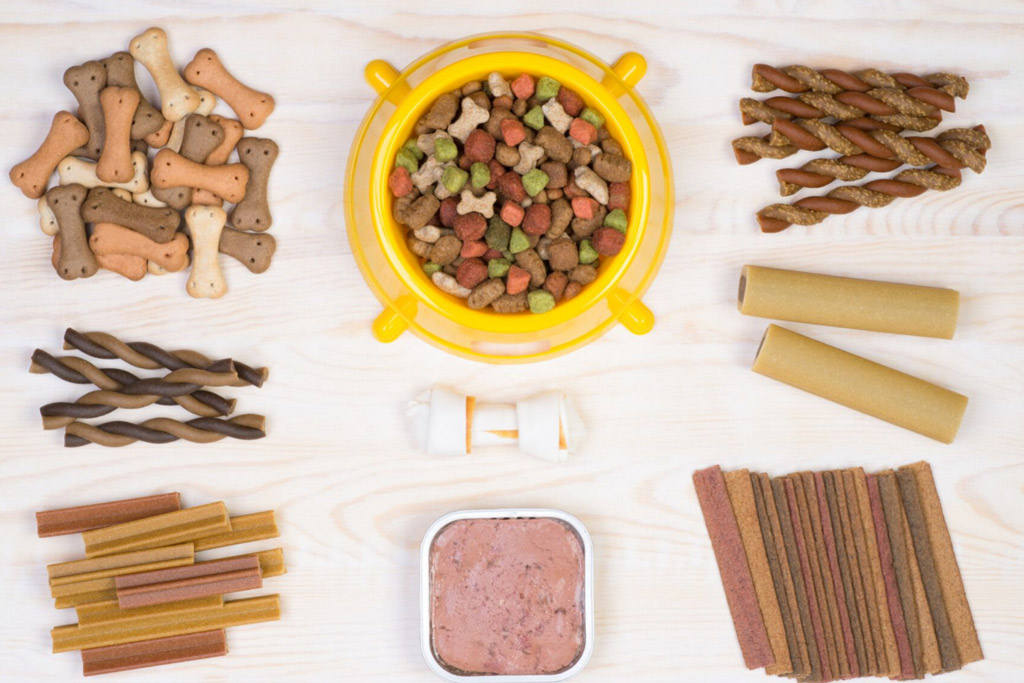
Healthy Treats
Treats are a great way to reward your dog’s good behaviour and the fact that he learnt a new trick. But you might be wondering which are the best treats for your dog.
A high-value dog treat will be healthy and nourishing for your dog. He will not only enjoy the reward but will also be motivated to work hard to receive it again.
Also, dog treats – even very healthy ones – should not constitute more than 15% of your dog’s daily food intake, and preferably less than 10%.
It’s best to limit them to:
- Training and behaviour rewards.
- As a bedtime ritual.
- Or as a “time to get in your playpen/crate” enticement.
Bear in mind that overfeeding treats on top of daily food intake will result in an obese dog.
Plus, overfeeding treats while underfeeding balanced meals will result in a dog with nutritional deficiencies.
To keep your dog’s treats healthy, you probably want them to:
- Have natural ingredients (free of preservatives and additives).
- Come from a reputable source.
- Be a single ingredient treat.
Unfortunately, many commercial dog treats contain ingredients that are high in sugar and carbohydrates, which ultimately can contribute to many dog illnesses and cause inflammation (especially with the carbs).
That’s why I recommend natural ingredients and even single ingredient treats.
Want some ideas on the dog treats that will be best for your pup? In my favourite dog treats post, I share what I think and highly recommend.

Human Superfoods for Dogs
Here is a list of 7 human superfoods perfect for sharing with your dog. They are ideal as treats or as part of their meal.
- Blueberries.
- Broccoli.
- Fermented foods.
- Kale.
- Pumpkin seeds.
- Sardines.
- Sweet potatoes.
Toxic Foods for Dogs
There are human foods that are great for your furry friend, however, there are also some foods that are toxic to them.
Here is a list of 9 human foods that are harmful to your dog:
- Onions, garlic and chives.
- Chocolate.
- Macadamia nuts.
- Corn on the cob.
- Avocado.
- Sugar and artificial sweetener.
- Alcohol.
- Cooked bones.
- Grapes and raisins.
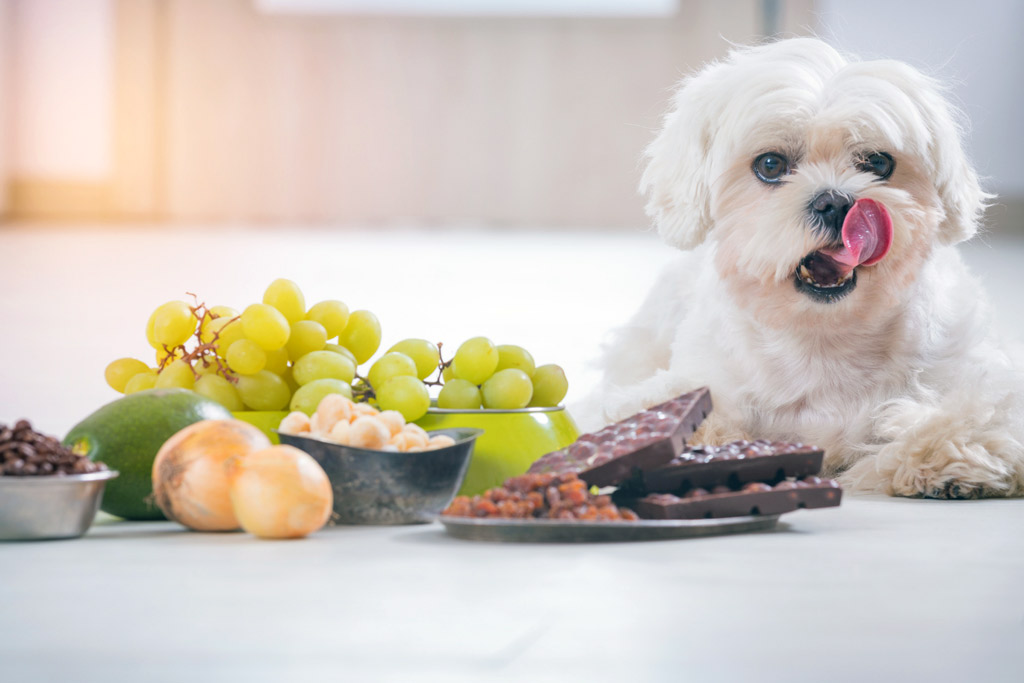
#3 – Activities
Dogs especially need both exercise and mental stimulation to be optimally healthy and well-balanced.
That’s why exercise, playtime and training should be a part of your dog care routine.
These activities benefit both you and your dog.
One of the reasons is that humans release oxytocin, also called the “love hormone.” Human and animal studies have shown that oxytocin plays a role in bonding; when released in your brain during certain types of human or animal contact, it has the effect of bonding you to the other person or dog involved.
Before addressing the three essential activities, it’s important to establish a dog schedule. Here’s why:
Dog Schedule
Dogs thrive on routine. The daily schedule helps your dog to know what to expect and when. Also, it helps you to take better care of your dog.
When planning to establish a dog schedule, here are the things you need to make time for daily (all related to dog care pillars):
- Feeding times.
- Potty breaks.
- Dog walks.
- Playtime.
- Cuddle time.
- Training session.
- Grooming.
Once you establish a daily routine, remain consistent on both weekdays and weekends as much as possible, since dogs can find erratic changes in their schedule stressful.
Before jumping into an example of how your day could look like, your dog’s schedule will really depend on yours.
For example, I have found that for a low-energy dog, a longer walk later in the morning works great to burn energy, which then leads to them having a nap in the afternoon when I might pop out and leave my dog at home.
If I can only fit one long walk in the morning, then I schedule playtime in the evening.
You can also decide on feeding times knowing when you could take your pooch to release himself.
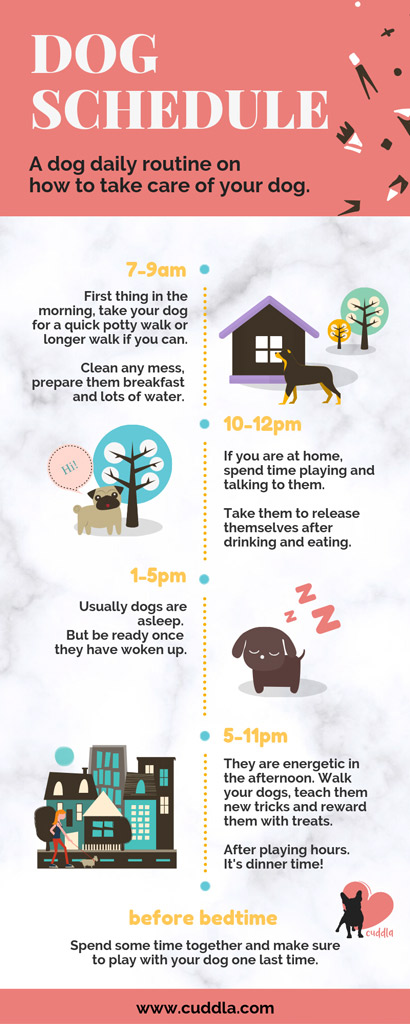
Exercise
Beyond potty break walks, your dog needs longer walks. These keep him mentally and physically healthy.
Without enough exercise to stimulate their mind, some dogs become anxious or destructive.
According to VCA Animal Hospitals, the one-on-one time spent on walks can help deter attention-seeking behaviours like whining or barking. Plus, it’s a great way to bond with your dog.
Different dogs have different walking needs. However, walking is a type of exercise that is beneficial for every dog. They need daily exercise to stay in shape, both physically and mentally.
As this physical activity depends on their particular needs, we’ll touch on the three key factors that determine how much walking your dog requires:
- Dog breed.
- Dog age.
- Dog energy levels.
And given that your schedule will play a role, I believe this is a crucial fourth factor.
When exercising your dog, apart from going for walks, you can add some power walks to help him get the aerobic exercise he needs for good cardiovascular health.
Combine these walks with a leash training session to improve your doggy’s manners on the lead manners.
For more about dog walks and how much exercise your dog needs, check out our How often should I walk my dog? blog post.
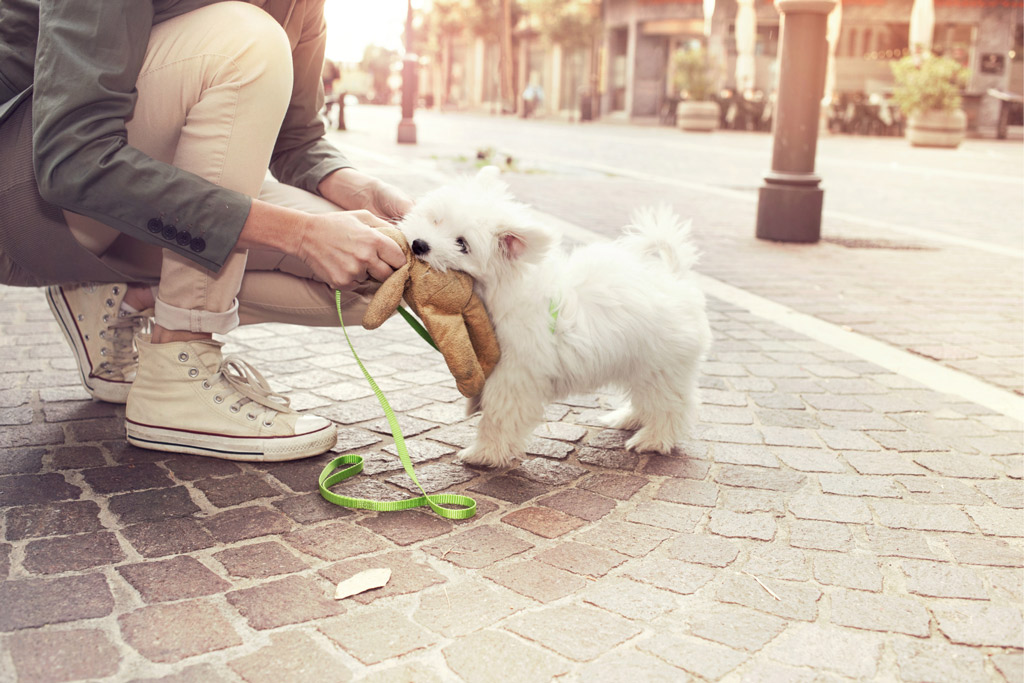
Playtime
Introducing dog play to your dog’s daily routine is a fun and engaging way to contribute to your furry friend’s wellbeing.
Here’s a list of activities that can help your dog stay healthy and have fun:
- Fetch games for extra exercise.
- Tug games when you are tired.
- Treat-release toys for break-time.
- Digging adventures with a sandbox.
- Arrange a playdate.
- Teach your dog new tricks.
A topic not emphasised as often as it should be is brain games, which are fun games that you can play with your dog to teach him new skills and increase his intelligence.
Take your dogs health, intelligence and behaviour to the next level by teaching your pup new tricks in a fun and highly rewarding way. All covered in my favourite training method.
Likewise, if you’re looking for more ideas on how to have fun with your dog, our Dog Play: How to Keep Your Dog Physically and Mentally Active blog post is the next best step – head over there for some new, interesting tips you can easily start applying today!
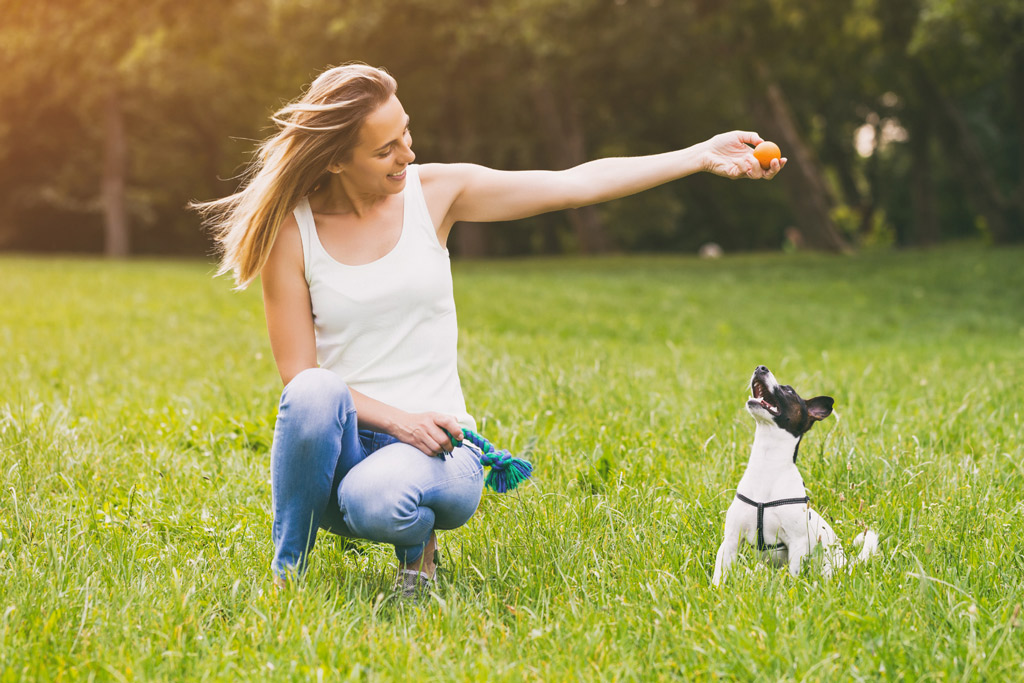
Dog Training
No matter your dog’s age or breed, all dogs need continuous training to keep their mind stimulated and to prevent unwanted behaviours mostly due to lack of training and boredom.
I personally prefer positive reinforcement training.
Reward-based training is not only more successful than other training methods but also means you and your dog can work towards a positive relationship that will serve as a good foundation for future training.
This method consists of rewarding your dog’s good behaviour immediately after it happens with praise, a caress or a healthy treat. The big takeaway of this method is that it encourages your dog to repeat good behaviour.
Reward-based training also involves generally ignoring any ‘unwanted’ behaviours. If dogs are not rewarded (i.e. receives no attention or treats) for a certain behaviour, then they tend to stop doing it.
Training should be fun!
To find out more about reward-based training and how to implement it in an enjoyable way (I encourage you to do so!), check out my favourite training method.
At first, dog training can be pretty overwhelming, especially if this is your first dog.
Start by house-training your dog, which will lay the foundation and also prepare your dog for a lifetime of good behaviour.
Housebreaking (or house-training) consists of:
- Crate training.
- Leash training.
- Potty training.
- Basic commands.
- Socialization.
Once your dog knows many of the basic commands, you can work on teaching him tricks and more advanced commands.
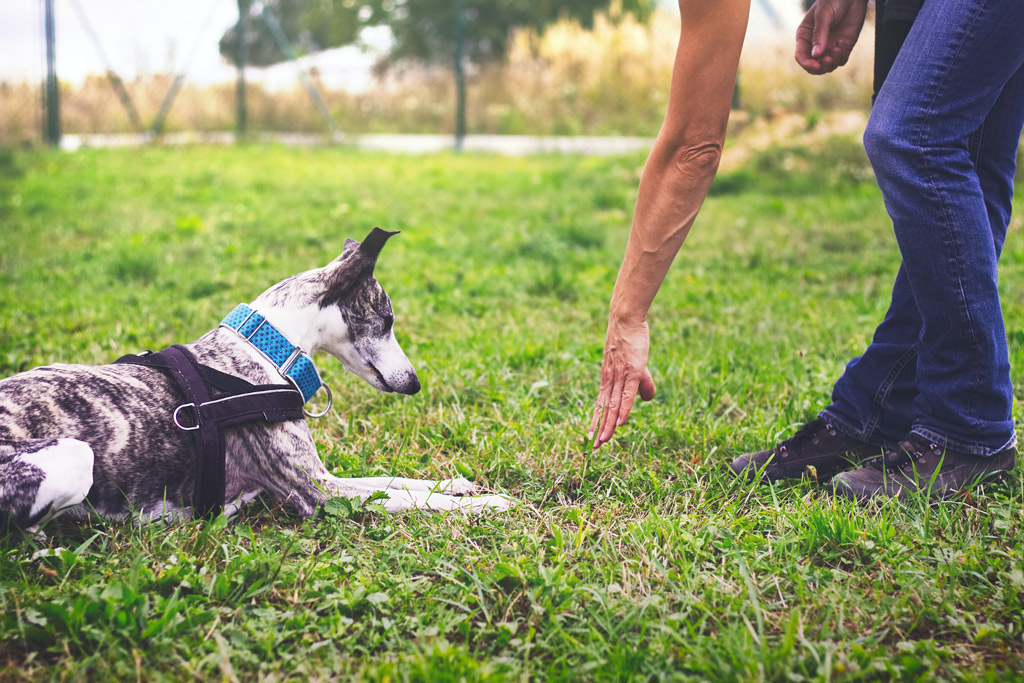
#4 – Health
For your pooch’s optimal health, prevention is key.
This is where nutrition, exercise, grooming and a dog-friendly environment makes a difference in your dog’s life quality.
However, this doesn’t rule out the chances of your dog getting sick.
Maintaining Your Dog’s Health
Regular Physical Examinations at Your Vet
Regular visit’s to your vet is a fundament part to maintaining your dog’s health and keeping an eye on current illness, if any.
Periodical physical examinations are great to assess your dog’s health and also might diagnose a disorder.
Find a veterinarian that shares your values; it’s important to know which treatment approach you prefer for your pet.
In veterinary medicine, there are allopathic practitioners, holistic practitioners, and integrative practitioners.
Vaccinations Schedule
The vaccination schedule usually starts at the age of 5 to 6 weeks.
It is always better your pup has a worming treatment before the vaccination.
The booster dose for each vaccine needs to be given at an appropriate time and this helps to build up the immune status to an appreciable manner.
Dog Dental Health
Dog health also applies to oral care.
If there is evidence of bleeding from the mouth, your pup needs to be examined thoroughly for any dental abnormality.
Our Dog Grooming at Home blog post will give you the necessary information you need on dog dental hygiene practices, like how to brush your dog’s teeth.
Dog Health Checklist at Home
As part of maintaining your pup’s health routine, you can follow this checklist to complete a thorough examination of your dog, once a month. This way you could help pick up any early signs of illness or injury.
This dog health examination at home consists of checking your dog’s:
- Ears.
- Eyes.
- Nose.
- Mouth.
- Skin and coat.
- Paws and nails.
- Bones and joints.
- Bodyweight.
- Heart and lungs.
- Digestive system.
- Urinary system.
- And attitude.
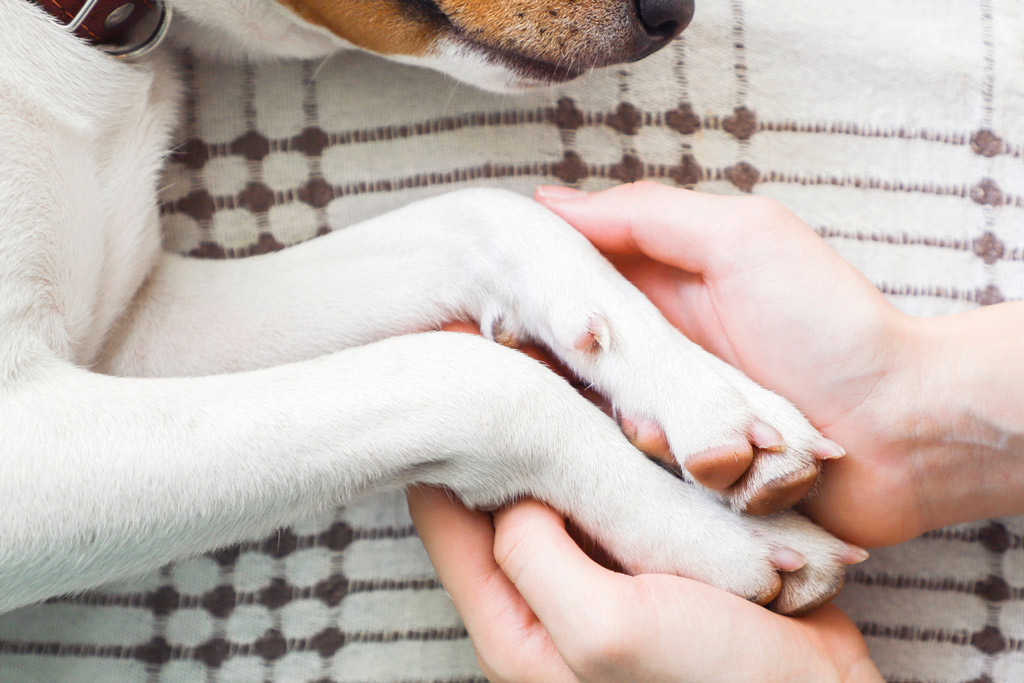
Common Dog Health Concerns
Parasites
Dog parasites such as worm, fleas, ticks, mites and lice should be eliminated as soon as possible.
There are many commercial products for different parasite treatments. However, there are also natural parasite treatments and prevention tips that you can use.
Parasites cause high discomfort, including skin rashes and irritation, itchiness, fever, diarrhoea, etc.
There is a whole lot more insightful information about dog parasites and the things you can do about them, in our Dog Parasite Prevention and Treatment blog post.
Spaying and Neutering
Spaying and neutering dogs are highly practised.
This is a surgical approach to sterilization in female and male dogs, respectively.
Spaying is used when referring to both sexes.
However, you might find that there’s no need for these practices to maintain your dog’s health whilst still avoiding unwanted pregnancies for your pooch.
For the most common dog health concerns (like parasites, spaying and neutering, vomiting, etc) and further detailed information on how to maintain your dog’s health, our Dog Health: The Ultimate Guide to Wellbeing and Longevity blog post is my top recommendation.
Dog Health Insurance
As a dog owner, you’re well-acquainted with the expenses and commitments associated with your pooch. Besides food and toys, vet costs can be a recurrent expense, and unforeseen accidents and illnesses are always a possibility.
Whether you have an adult dog or puppy, it’s wise to look into protecting your furry family member rather than waiting until you need insurance.
Consider setting some money aside on a monthly basis or investing in a pet insurance policy today.
Insider tip: The best insurance option for your doggy will depend on your needs and budget. It’s always good to read honest reviews by other pet owners and compare the different options out there.
I recommend heading over to Best Pet Insurance Based on In-Depth Reviews by consumersadvocate.org. Also, many websites offer tools like premium costs calculators that can help you better understand deductible amounts and reimbursement percentages.
If you decide that pet insurance is out of the question, or out of your budget, I highly encourage you set money aside for your pet’s expenses. Just like bringing your pup into your life, that’s a decision you’ll never regret!

#5 – Grooming
The last dog care pillar is dog grooming.
It contributes to maintaining your dog healthy. The dog grooming routine involves a few things like:
- Brushing your dog’s coat.
- Cleaning your dog’s ears.
- Cleaning your dog’s eyes.
- Cleaning your dog’s paws.
- Bathing your dog.
- Trimming your dog’s hair.
- Clipping your dog’s coat.
- Trimming your dog’s nails.
- Brushing your dog’s teeth.
“Being good for your dog” doesn’t mean that he will like it.
Some dogs are easy going and they let you brush them and bathe them without a fuss.
Others can get quite uncomfortable, so you will have to take it easy and do a bit at a time until they gradually tolerate you grooming them. And hopefully, they will like or tolerate it enough in the future.
The goal is to make grooming a positive, stress-free experience for both you and your pooch.
Start small (i.e. short sessions) and try to restrain your doggy as little as possible. Also, reward your dog for staying calm with praise or high-value treats.
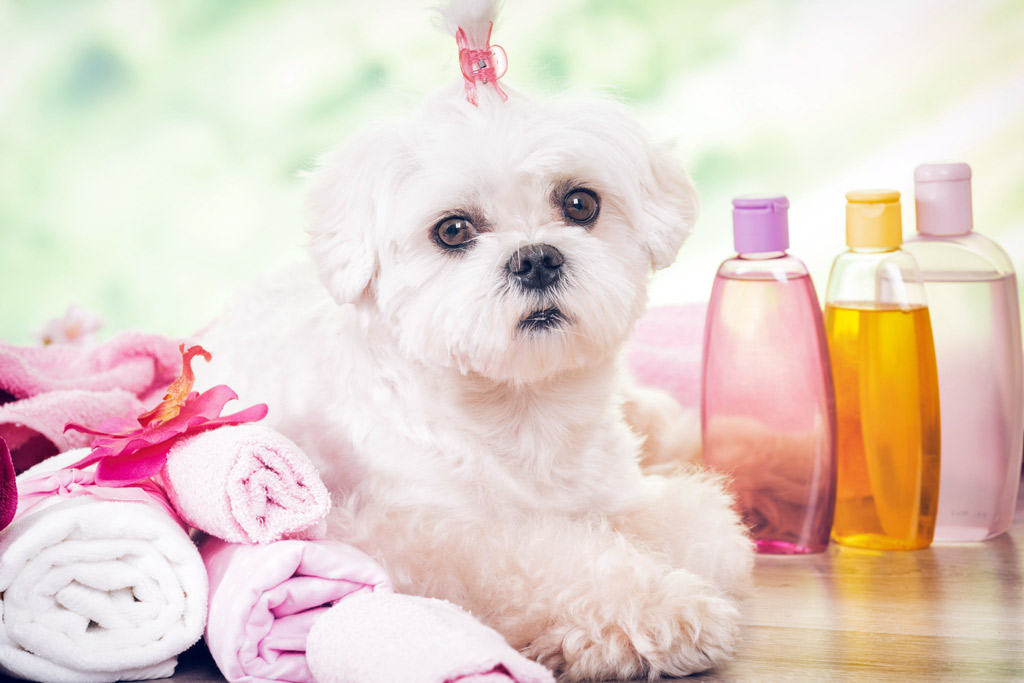
Grooming Routine
Brushing Your Dog’s Coat
Just a few minutes of brushing helps remove dirt, excess hair, tangles and mats while distributing oils that help keep the skin and coat healthy.
Some dogs need more brushing than others, especially those with long hair and double-coated dogs that shed their undercoats seasonally.
In the beginning, try brushing your dog a few times a week for a few minutes at a time to create a routine. Once your dog is used to it, you should brush him every couple of days no matter the length of his coat.

Trimming Your Dog’s Nails
In general, you should plan on trimming your dog’s nails once a month.
Some dogs will need more or less frequent nail trimming. You can use a nail clipper or a rotary tool (grinder), depending on what your dog can tolerate and your own preference.
Nails must be trimmed very carefully to avoid cutting into the pinkish quick.
The first rule of nail trims is to clip enough, but not too much. It can difficult to see the quick if your dog has dark nails.
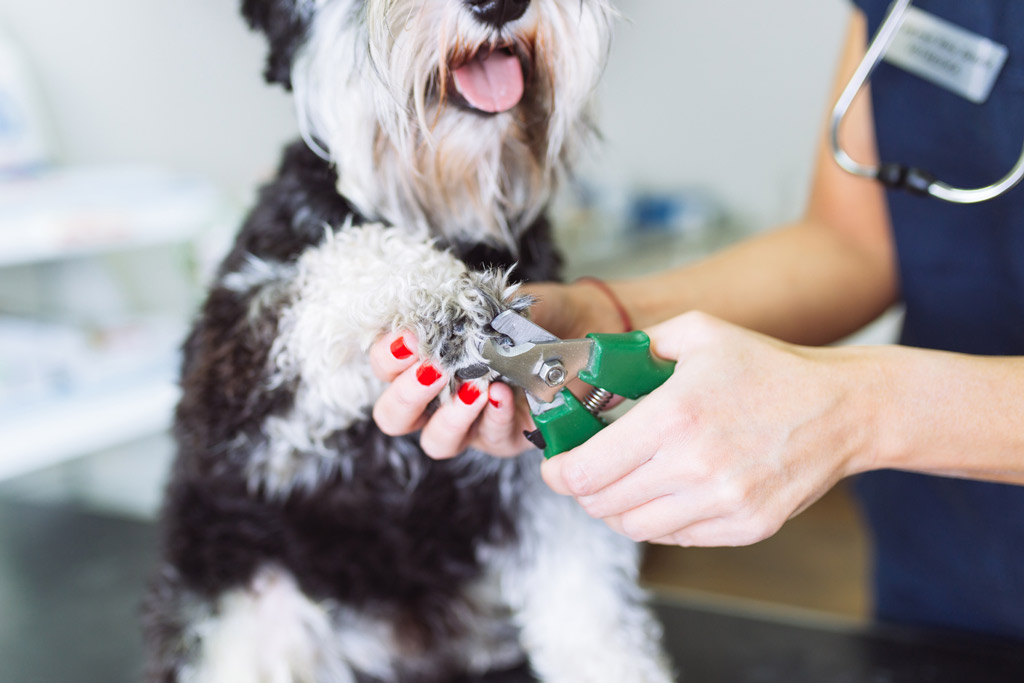
Bathing Your Dog
As a rule of thumb, dogs should only be bathed when they are dirty or stinky since they need the natural oils in their fur to keep their coats and skin healthy, and frequent bathing strips these oils out of their skin.
On days when you don’t give a full bath, you can give her a quick foot bath, keeping her paws clean will make her more comfortable.

Brushing Your Dog’s Teeth
A species-appropriate diet is crucial for your dog’s overall health, including their teeth.
Raw bones, for example, are a great way to strengthen your dog’s gum in a natural manner.
However, regular at-home dental care is still needed for good dental health. Since they can’t do it themselves, it’s up to you to take responsibility and do it for them.
Finally, for more about dog grooming tips, check our Dog Grooming at Home blog post.
